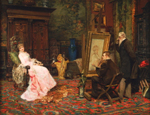
What Is Real?
"'in the deceptive atmosphere of art even the highest
respectability
may fail of being plastic."
Henry James's "The Real Thing" (1892, 1909)
Points
for Reflection
H. James’s "The Real Thing" (1892, 1909)
- at what moments does James employ his story's title, and how does its meaning and value change over the course of the story? What artistic theory slowly emerges from the narrator as he discusses the limitations of his new models?
- how does the narrator respond to the Monarchs' efforts to show off their figures? How does a 21st-century audience respond (OER 72-73)?
- does the Monarch marriage appear ideal in any way?
- what does the narrator mean by his claim that he has "an innate preference for the represented subject over the real one" (OER 74)?
- what types of jobs has the Major applied for in the recent past, and how "low" are he and his wife willing to descend by the end of the story?
- does the narrator’s opinion of Raphael Sanzo dovetail with that of the Pre-Raphaelites, and does his implied estimation of Leonardo da Vinci gel with either Pater’s or Ruskin’s opinion of the Renaissance painter (OER 79)?
- does Henry James’s reproduction of Miss Charm’s Cockney accent serve to either elevate or denigrate her?
- do the Major and his wife evince any virtues unrelated to their relative (small) value as models?
- after meeting the Major and his wife, Jack Hawley calls them "ridiculous" and reiterates his claim that they have "no business in a studio" (OER 84). Why, exactly, is he so dismissive?
- if you had to sketch the character and temperament of the unnamed narrator, what attributes would you assign him?
Charles Chesnutt's "The Goophered Grapevine" (1887)
- does Chesnutt’s employment of dialect, inflected by the local color of colloquial speech, weaken or enrich his storytelling?
- the narrator explains that as the older man of color who tells the tale warms to his theme, his language flows more freely, and that his story “acquire[s] perspective and coherence” (3). Can you trace this process of refinement as the story progresses?
- what do you make of the hair growth resulting from Aunt Peggy’s treatment of Henry? Does this play out as low comedy, or light fun? Does it provide an oblique commentary on the natural hair growth and characteristic stylings of African Americans?
- does Charles Chesnutt appear to validate or mock the goophered tale at the heart of his story, and those whose self-interest would lead them to spontaneously spin such tales?
EBB's "Lord Walter's Wife" (1862)
- as the Broadview editors explain, the author of Vanity Fair (a novel) and editor of the Cornhill Magazine declined to publish this poem by Barrett Browning, having categorized it as an “account of unlawful passion” inappropriate for readers of all ages. What about this poem might have earned it such an assessment from William Makepeace Thackeray?
- at what point does the poem turn and begin to reveal the speaker’s true endgame?
- should we take the suitor’s desire to go, in order to save himself, at face value?
- why might Barrett Browning compare the lady’s eyes to the Kraken (l.2)? In your answer, consider Tennyson’s short poem “The Kraken” (183).
- is this woman actively encouraging her companion to utter his provocative observations about her attractions? Is she toying with or testing him?
- is the poem’s female speaker an adulterous flirt, or is she a faithful wife determined to defend her marriage?
- what precipitates the male speaker’s anger and conclusion that his companion has suddenly lost her beauty (ll.19-20)?
- is the disdain she shows in response to his own anger earned (ll.21-22)?
- why might the wife have broken the fan her companion once kissed (l.36)?
- what might it mean that her companion was once “‘moved at [her] side now and then / In the senses,’” and why consider this an “‘honor’” (ll.37-38)?
- is she celebrating illicit love, or marital fidelity, in lines 39-40?
- does the narrator appear to have invited her companion to “‘falter’” for a week (ll.41-42)?
- what truth has she determined to show her auditor (ll.45-46)?
- is she calling herself clean, or unclean, by comparing her eyes to a man’s palm (ll.47-48)?
- explain the vertiginous, contradictory movement of the narrator’s words in the concluding couplet (ll.53-54).

The Artist's Studio (1879)
W. S. Gordon
Dr. Paul Marchbanks
pmarchba@calpoly.edu
![]()
